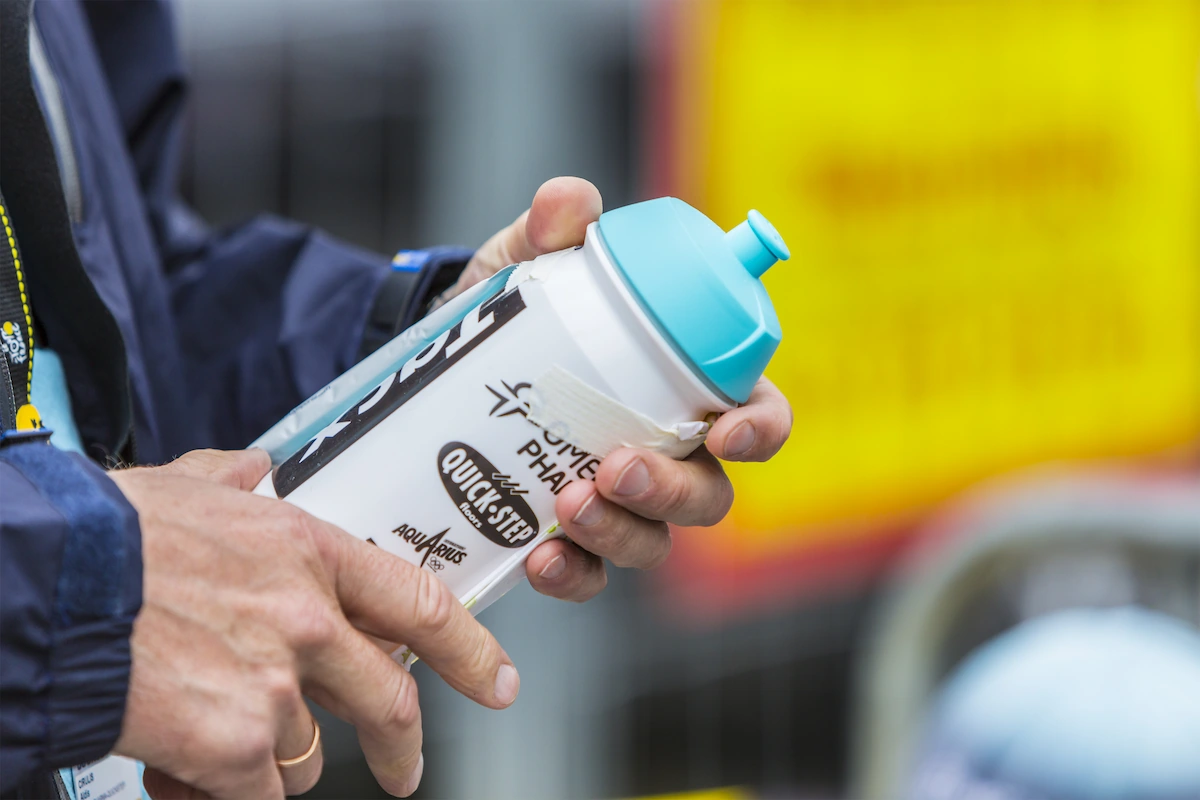A bidon or water bottle is essential to a cyclist’s equipment. And while cyclists like you and me always keep a bidon, professional cyclists don’t.
Once they’ve drunk the contents, they throw it away and are soon given a new one. This means that at every race, a lot of bidons are lying on the side of the road that someone has to pick up. But does anyone really?
As of 2021, cyclists must discard the bidons in designated waste zones or any car in a caravan. They may also throw them to the spectators but must do that in a safe manner without endangering spectators or fellow cyclists. Any spectator who catches the bottle can keep it as a souvenir.
Although cycling is one of the most environmentally friendly sports at first sight, there are many things going against it. One of them is the dumping of bidons, although things have improved a lot in this area recently.
Why Do Cyclists Throw Away the Bidons?
Cycling is a sport where every gram counts. Anything that has no function on the bike must be removed as soon as possible.
An empty bidon is a dead weight for the rider. He will not refill it, so the only sensible decision is to get rid of it.

For amateur cyclists, the bidon’s weight is unimportant as it does not make any difference. It’s different for professionals who don’t want to carry a gram of extra weight uphill.
The lightest bidon weighs less than 50 grams (1.6 ounces), making it one of the lighter pieces of equipment, but if it has no function for the rider, he will remove it from the bike. Races are often decided by seconds, so carrying an extra 100 grams (3 ounces) of weight might make a difference between winning and losing.
Bidon Etiquette at Cycling Races
I’ve been to quite some races but am yet to collect my first bidon from a pro. It seems that this gets harder and harder with new rules, as cyclists have started to return the bidons to the cars or throw them away in waste zones.
Not that long ago, cyclists could throw the bidons pretty much anywhere they wanted. Except at another cyclist (they are still not allowed to do that). Then people started complaining when they saw how many bidons were left in the beautiful nature, where no one can get to them.
Then, in 2021, new rules were introduced that clearly defined how cyclists could discard the bidons. There were some initial problems with them, and some minor adjustments were needed, but eventually, we got pretty clear guidelines on how cyclists could get rid of their bidons.
Acceptable Practices
Cyclists have three options to discard a bidon:
- Return it to any car
- Throw it away in a waste zone
- Throw it to the spectators
Return It to the Car
The most used way of discarding a bidon is by returning it to the car. Rules state that they can return it to any car, whether the official’s, medic’s, team’s, or opposing team’s car. Every car must accept the bidon and ensure it is properly disposed of.
Cyclists like to return the bidons to the car as it’s the only way they can do it at any time. They also instantly get a new full bidon. And last but not least, they can take advantage of a sticky bottle, which they never refuse.

Throw It Away in a Waste Zone
Since introducing new rules, race organizers have been forced to set up waste zones every 30-40 kilometers (18-25 miles). Inside, cyclists can throw away all litter, including bidons. The organizer then ensures that all litter in the waste zone is picked up and removed from nature.
You can see energy gel wrappers flying out of pockets and bidons flying off bikes in the waste zones. They are a ‘goldmine’ for bidon collectors, who can easily get their hands on them.
Throw It to the Spectators
The most desirable form of bidon disposal amongst fans is for cyclists to throw them at them. And this is where it gets complicated.
The new rules originally prohibited the throwing of bidons at spectators. A few riders were even disqualified for this. It was only when cyclists and fans complained loudly that the rules were changed.
Now cyclists can throw a bidon to a fan, but they must do so in a way that does not endanger other cyclists or spectators. In practice, this means that the cyclist drops the bidon on the edge of the road, where it is picked up by the lucky fans.
Prohibited Actions
The rules are quite clear on what cyclists are not allowed to do with their bidons.
Gone are the days when bushes full of bidons were left behind after a race. Littering in nature where there are no spectators is forbidden and leads to financial fines or even disqualification.
It is also forbidden to throw away bidons at the end of sprint stages, especially in the last 3 kilometers, even if there are spectators. There is too great a risk of a rider riding over a bidon and falling at speeds over 60 km/h (37 mph).
Souvenirs for Fans
What guitar picks are at a rock concert, bidons are at a bike race. People fight over them to have a souvenir from a race. Those bidons are not used anymore, they find a special place in a memorabilia box.
For most people, the bidons are a reminder of the race they saw live. They want a souvenir that will stay with them forever.
What guitar picks are at a rock concert, bidons are at a bike race.
It’s not uncommon for a fan to receive a bidon from one of the riders and thus form a special bond with them. The cyclist who gave him a bidon (if it is possible to find out who it was) becomes the cyclist he roots for in the future because he is bonded to him by an unforgettable event.
In the past, we have read stories of cyclists who started cycling when they were young because they received a bidon at some race. They saw cyclists as heroes and wanted to be one themselves.
This was one of the main arguments used by cyclists and fans to appeal against the new rules. Encouraging children to become cyclists has been a good enough argument so the youngest fans can again receive bidons from their idols.
Environmental Impact

Throwing away bidons in the wild has a huge negative impact on the environment. Manufacturers are trying to be as environmentally friendly as possible, so biodegradable bidons have been recently used. They decompose within three months with the help of moisture, heat and UV rays.
Still, even a biodegradable bidon is litter, especially when you consider how many bidons are used every year.
Around 630,000 bidons are used every year in a professional peloton.
Based on the EF Education-EasyPost team data, they use 755 bidons per cyclist per year. There are 520 riders in the World Tour teams alone, i.e., at the highest level. They alone use 392,600 bidons a year, and there are many more cyclists in the lower-level teams. A total estimate of bidons used in professional cycling each year is 630,000.
You can see why the new regulations have been introduced. It is certainly unacceptable to have half a million bidons or more lying around in nature every year.
If new rules reduce littering by 95%, and I think they did, that means there are suddenly only 31,500 bidons thrown into nature yearly. It is still a considerable number, but much better than the over half a million that we witnessed before.
Safety Concerns
One of the reasons why throwing away bidons anywhere is no longer allowed is safety – for cyclists and spectators both.
Although bidons have not caused many accidents in the past, they have caused some. And if a simple rule can almost eliminate them, there is no reason why such a rule should not come into force.
Riders safety
The bidon lying on the road measures 8 centimeters (3 inches) in height. This is a high and dangerous barrier for a cyclist. If it’s closed, which prevents air from getting out quickly if run over, it’s as dangerous as a rock on the road.
If a cyclist rides over a bidon with his narrow tire, there are two possible outcomes:
- He may get lucky, and the bidon rolls away on contact with the tire, getting out of the cyclist’s way.
- He may ride over it, lose control of the bike, and, in most cases, crash. Any crash at high speed is extremely painful and dangerous.
Professional cyclists are extremely skillful on the bike, but in certain situations, avoiding a lying bidon and, consequently, a crash is impossible.
By throwing away the bidon in designated areas only, cyclists can be more alert to potential hazards and ride a little slower in the waste zone or leave themselves a little more space to deal with potential problems.
Spectators Safety
Flying bidons also pose a threat to spectators. The impact of an empty bidon hitting your head is already not a pleasant experience, but sometimes cyclists throw away half-full bidons. You can imagine how painful that can be.
Waste zones are usually set up in less populated areas, i.e., out of town. That means there are fewer spectators, so flying bidons don’t endanger them. The few that are there, however, can more easily get away from a potentially dangerous bidon.

